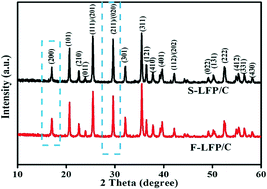High-tap density LiFePO4 microsphere developed by combined computational and experimental approaches†
Abstract
The lithiation/delithiation in LiFePO4 is mainly anisotropic with lithium-ion diffusion being mainly limited to channels along the b-axis. However, the tap density of the two-dimensional nanosheet of lithium iron phosphate is less than 1.0 g cm−3. Based on a host of experimental results, herein, we report the preparation of the flower-like LiFePO4 microsphere that is self-assembled from almost exclusively {010} single crystalline nanosheet. The flower-like LiFePO4 microsphere shows a high tap density (1.36 g cm−3). The as-synthesized cathode material shows fantastic high-rate specific capacity and volume capacity. Moreover, we propose the theoretical analysis model of the relationship between the spherical particle size distribution and the tap density. The mathematical model of the core ball as the center and the ball of radius 2r as the packaged ball makes a good theoretical analysis for the tap density of haphazardly packed microspheres. At the radius ratio of 0.4 ≤ r/R ≤ 0.7, the tap density decreases with the increase in radius ratio. At a threshold value of radius ratio r/R = 0.7, the haphazard accumulation of binary unequal spheres is regarded as the sphere with the same particle size and the tap density does not increase with r/R.



 Please wait while we load your content...
Please wait while we load your content...